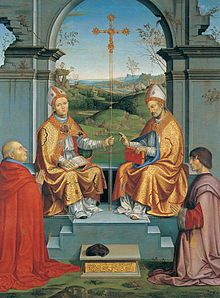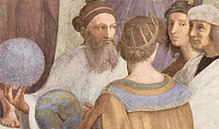Timoteo Viti
Timoteo Viti , also Timoteo della Vite , Timoteo da Urbino, (* 1469 in Urbino ; † 1523 ibid) was an Italian Renaissance painter , best known for his connections to Raphael .
Life
Viti was the grandson of the painter Antonio Alberti . After Giorgio Vasari , he went to Francesco Francia in Bologna to train as a painter, after having first trained as a goldsmith. There is no other documentary evidence of this, but his style showed influences from the Bologna School. In 1495 he returned to Urbino and became a painter at court there as the successor to the recently deceased father of Raffael Giovanni Santi , whose paintings of muses in the ducal palace he completed. It is possible that he supported Raffael, who was eleven when his father died, who continued his workshop and taught him. What is certain is that they later became friends and after Raphael's death Viti inherited most of his drawings.
He worked for Cesare Borgia in 1503 and painted banners for him when he temporarily conquered Urbino, and in 1504 he and Girolamo Genga commissioned him to paint in the Cathedral of Urbino (Chapel of San Martino) - one of his main works also dates from this period, the Bishop with the Duke and Saints Thomas Becket and Martin, stylistically influenced by Perugino . In 1508 he painted with Genga in the Palazzo Petrucci in Siena .
Around 1511 he was in Rome and saw pictures by Raphael who then strongly influenced his style for a while, including the altarpiece Noli me tangere in the church of San Angelo Minore in Cagli . In 1514 he was one of the painters Raphael hired (Vasari) for the frescoes in Santa Maria della Pace (Chigi Chapel) in Rome.
In later works such as the Madonna with Saint John and Sebastian in the Brera Gallery, he again turned away from Raphael and towards the style of the late 15th century, and in his later works (e.g. Maria Magdalena, Cathedral of Gubbio 1521) his style loses its lightness possibly because he was supported there by many students in his workshop.
After Vasari he was also a poet and musician. In 1508 he was on the city council of Urbino and in 1513 mayor.
It is possible that Raphael depicted him on his right as the Greek painter Protogenes (Raphael represented Apelles ) in the school of Athens, but perhaps it is also Raphael's teacher Perugino.
A cross fresco in the refectory of the Camaldolese monastery in Bologna is attributed to him (now the Great Hall of the Faculty of Fine Arts, University of Bologna).
Works (selection)
- Frescoes in the Palazzo Petrucci in Siena with Girolamo Genga, 1508
- Madonna and Child with Saints John and Sebastian, for the Cathedral of Urbino, Pinacoteca di Brera
- Madonna with Saints, Galleria Nazionale delle Marche in the Palazzo Ducale of Urbino, 1514 (originally for the Cathedral of Urbino)
- Saint Thomas Becket and Saint Martin with Archbishop Giovanni Pietro Arrivabene von Urbino and Duke Guidobaldo da Montefeltro , 1504, Ducal Palace Urbino
- Maria Magdalena, originally for Urbino Cathedral, 1508, Pinacoteca Nazionale di Bologna
- The muse Thalia with Apollo, originally for the Temple of the Muses in Palazzo Montefeltro, Urbino, Galeria Corsini, Florence
- God the Father, Pinacoteca Ambrosiana (Milan)
- Noli me tangere, Sant Angelo Minore, Cagli
Web links
Individual evidence
- ↑ Vasari, engl. translation
- ↑ Nicosetta Roio Una traccia bolognese per Timoteo Viti ( Memento of the original from October 16, 2009 in the Internet Archive ) Info: The archive link was inserted automatically and has not yet been checked. Please check the original and archive link according to the instructions and then remove this notice.
| personal data | |
|---|---|
| SURNAME | Viti, Timoteo |
| BRIEF DESCRIPTION | Italian Renaissance painter |
| DATE OF BIRTH | 1469 |
| PLACE OF BIRTH | Urbino |
| DATE OF DEATH | 1523 |
| Place of death | Urbino |


